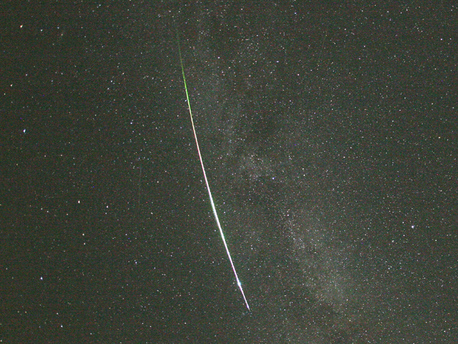Wishful Meteors
What Are Shooting Stars?
 © DLR
|
A bright meteor, observed on August 13, 2007 from the geodetic observatory at Wettzell, in Bavaria. As part of the 'European Fireball Network' every night, 25 automatic camera stations scan the skies above Central Europe and, when visibility is good, record all meteors.
These meteoroids, usually no more than a 1/16 of an inch in diameter, originate from asteroids and comets. Most commonly, meteors occur sporadically and in isolation. Sometimes, though, meteor showers occur, when more than 100 shooting stars per hour can often be observed. What causes this to happen?
For the most part, meteor showers are caused by comets that move close to the plane of Earth's orbit around the Sun (the 'ecliptic' plane). Whenever these comets approach the Sun, their surface ice starts to evaporate, ejecting particles of dust in the process. These particles then distance themselves from the core of the comet and commonly arrange themselves in a tube-shaped cloud. Whenever the Earth approaches one of these clouds of particles, a large number of the particles collide with Earth's atmosphere and burn up to create 'shooting stars' or, more accurately, to form meteors.
A meteoroid can give rise to a meteor, which then falls to Earth as a meteorite
Due to the fact that the orbits of comets around the Sun virtually never alter, encounters of this nature occur at regular intervals at certain times of the year. The best-known meteor showers are the Perseids (around August 12, dust from comet Swift-Tuttle), the Leonids (around November 17, dust from comet Tempel-Tuttle) and the Geminids (around December 13, dust from the object '3200 Phaethon', thought to be an extinct comet). If a larger meteoroid fails to burn up completely in the atmosphere, and then reaches the surface of Earth as a solid body, this is referred to as a meteorite.
German Aerospace Center
Wishful Meteors
What Are Shooting Stars?
 © DLR
|
A bright meteor, observed on August 13, 2007 from the geodetic observatory at Wettzell, in Bavaria. As part of the 'European Fireball Network' every night, 25 automatic camera stations scan the skies above Central Europe and, when visibility is good, record all meteors.
These meteoroids, usually no more than a 1/16 of an inch in diameter, originate from asteroids and comets. Most commonly, meteors occur sporadically and in isolation. Sometimes, though, meteor showers occur, when more than 100 shooting stars per hour can often be observed. What causes this to happen?
For the most part, meteor showers are caused by comets that move close to the plane of Earth's orbit around the Sun (the 'ecliptic' plane). Whenever these comets approach the Sun, their surface ice starts to evaporate, ejecting particles of dust in the process. These particles then distance themselves from the core of the comet and commonly arrange themselves in a tube-shaped cloud. Whenever the Earth approaches one of these clouds of particles, a large number of the particles collide with Earth's atmosphere and burn up to create 'shooting stars' or, more accurately, to form meteors.
A meteoroid can give rise to a meteor, which then falls to Earth as a meteorite
Due to the fact that the orbits of comets around the Sun virtually never alter, encounters of this nature occur at regular intervals at certain times of the year. The best-known meteor showers are the Perseids (around August 12, dust from comet Swift-Tuttle), the Leonids (around November 17, dust from comet Tempel-Tuttle) and the Geminids (around December 13, dust from the object '3200 Phaethon', thought to be an extinct comet). If a larger meteoroid fails to burn up completely in the atmosphere, and then reaches the surface of Earth as a solid body, this is referred to as a meteorite.
German Aerospace Center






